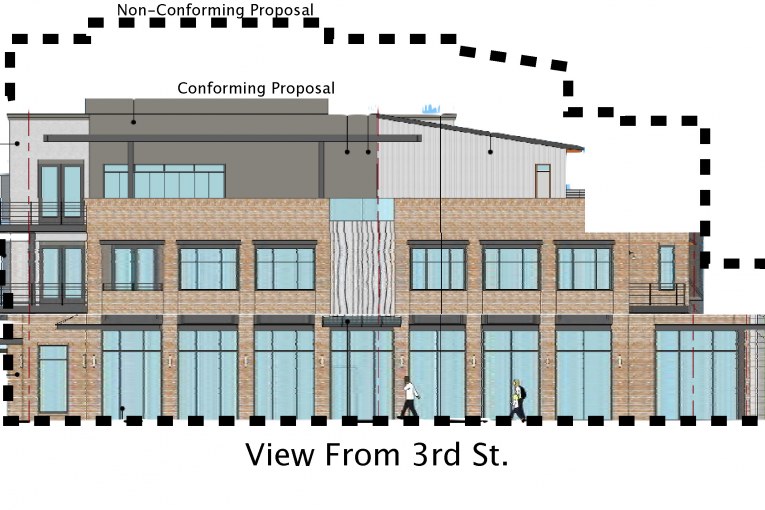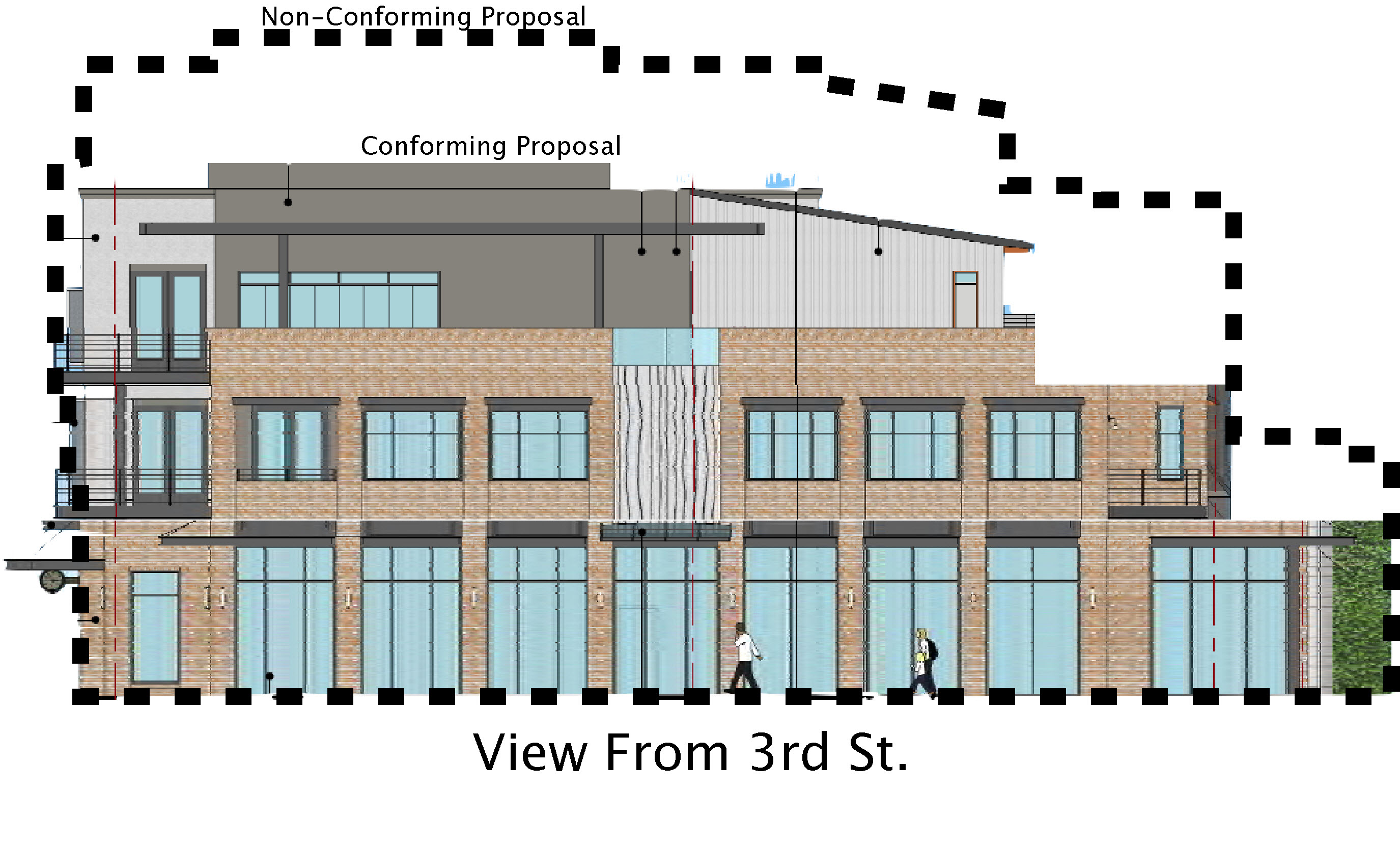

The council hearing on Trackside has been pushed back once again, this time to October 24. According to an email from Ash Feeney, Assistant Director of Community Development and Sustainability, “This rescheduled meeting date will allow staff time to further explore and finalize any modifications to the conditions of approval, and address items of concern that have been raised. Additional noticing will be provided prior to the hearing date.”
Trackside remains a hotly contested development.
The Trackside project in its latest iteration proposes to redevelop two existing commercial buildings just to the east of the railroad tracks north of Third Street.
The current design has a new four-story, 47,983-square-foot building with 8,950 square feet of commercial retail space on the ground floor, and 27 apartment units on the three floors above.
The project also includes 30 covered and uncovered parking spaces, an outdoor plaza on the west side, landscaping, bicycle and pedestrian facilities, alley improvements, and other site improvements.
According to the staff report from August at the Planning Commissions, the proposal would change the existing alleyway from a two-way to a one-way alley.
Apartment units include a mix of studio, 1-bedroom and 2-bedroom units ranging in size from 705 square feet to 1,537 square feet plus balconies. Thirty parking stalls are provided in a mix of 
covered and uncovered spaces. In addition to the apartment units and retail spaces, the building includes common areas for a manager’s office, lobby, mail room, bike storage, utility room, trash room, a lounge and roof terrace.
The Planning Commission process brought about a mixed result. By a 6-1 vote with Darryl Rutherford dissenting, the Planning Commission voted not to recommend that the council adopt the Initial Study. It was with a 7-0 vote that they voted not to recommend approval of the Design Review. But, by a 5-2 vote, the commission supported the Core Area Specific Plan Amendment and Rezone of the Planned Development, along with the demolition of the current site.
Most commissioners spoke supportively of the project, but chafed at the lack of guidance and information, particularly on the Initial Study and Design Guidelines. They have thus left these considerations for the council to sift through.
David Robertson said, “I’m torn because we haven’t been given direction by the city council – we must densify. On no uncertain terms, we must increase density in the city. We’re up against a huge problem as far as the amount of housing and this is a drop in the bucket, this number of units… we’re doing this piecemeal and I hate it.
“We’re so far away from meeting the housing needs,” he added.
“By the same token, if you’re going to densify, this project is very well-designed,” he added. “I’m favorably impressed by the project itself.
“I just have problems with the procedure that’s getting us there today,” he said, noting that, with other things in order, he would be supportive of the project and ready to recommend approval.
Darryl Rutherford agreed with his colleague on the project itself, in that “this is the type of project that’s potentially the future of Davis.” He said he hears the neighbors’ concerns on the size and scale of this, that it “could be quite daunting as you stand in the backyard… staring at this large building. But I’m not sure what else we’re going to be doing in this town.”
He suspects the whole corridor will be growing upward. He called the project “precedent setting.”
Meanwhile, the neighbors this week unveiled their own proposal that they see as viable but fitting within the space and existing guidelines.
Trackside 3.0, they write, achieves the following:
- Mass and scale consistent with the Design Guidelines;
- Floor area ratio of 1.5 consistent with mixed-use zoning;
- The same amount of commercial/retail space as the Trackside Partners proposal;
- Increased housing near downtown;
- Surpasses the Sacramento Area Council of Government’s goals for density near the railroad station;
- Significantly reduces impacts to adjacent single-story homes; and
- Creates a careful transition from a traditional historic neighborhood to the downtown core.
In an op-ed in the Vanguard, they argue: “The neighborhood association’s proposal is still a very large building: It has 45 percent more square footage than the four-story Chen building at Second and G streets, and it is larger than The Lofts on E Street, the largest mixed-use residential building in the downtown core.”
It remains the position of the neighbors that “[a]pproval of the Trackside Partners’ proposal by the City Council would violate the agreements designed to protect traditional neighborhoods from direct, overwhelming encroachment and unmitigated impacts.”
Now once again the city council has pushed back the final consideration of this project.
—David M. Greenwald reporting

